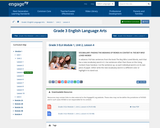
In this lesson, students answer questions using details from the text and explain why they chose specific details to answer questions from the text.
- Subject:
- English Language Arts
- Material Type:
- Lesson Plan
- Provider:
- EngageNY
- Date Added:
- 04/13/2017

In this lesson, students answer questions using details from the text and explain why they chose specific details to answer questions from the text.

Students will investigate the idea that gradual changes in landforms reflect changes in the Earth’s atmosphere caused by human activity and subsequent global warming. They will create classroom service announcements, detailing the possible causes of climate change and urging fellow students to take action, to become aware of the connections among their lifestyles and the preservation of landforms. Students will develop the perspective that daily activity in one place in the world can have an impact on the entire planet. This lesson was developed by Georgia Morrison as part of their completion of the North Carolina Global Educator Digital Badge program. This lesson plan has been vetted at the local and state level for standards alignment, Global Education focus, and content accuracy.

The goal of the first component of this unit design is to connect new learning and language to prior knowledge and build students’ background and interest of global poverty. They will begin to investigate the world and recognize perspectives by learning and thinking about the essential questions for the unit: What is poverty? What are some causes of poverty? What are the effects of poverty of children? Students are engaged in a variety of visual literacy tasks where speaking, listening and writing begin to occur through the support of graphic organizers and prompt cards with sentence frames linked to the speaking and listening standards (Zwiers 2008). This lesson was developed by Karie Gregory as part of their completion of the North Carolina Global Educator Digital Badge program. This lesson plan has been vetted at the local and state level for standards alignment, Global Education focus, and content accuracy.

In this component students are exposed to a quality piece of literature with themes and bigger ideas focusing on childhood poverty. They will continue to develop a deeper understanding of the bigger issues while building compassion for others living this way. As students read The Most Beautiful Place in the World by Ann Cameron, they will practice summarizing each chapter and describing Juan using a Character Map. Two key strategies are utilized to guide conversation and understanding of the bigger ideas and text themes. First an anticipation guide is used to introduce the big ideas and character perspectives found within the book ("Anticipation Guide" 2016). The second strategy used is a Triad conversation protocol, where students work in teams of three and follow a system that leads them through academic conversation. (Dewees & Nelson "WIDA National Conference"). This lesson was developed by Karie Gregory as part of their completion of the North Carolina Global Educator Digital Badge program. This lesson plan has been vetted at the local and state level for standards alignment, Global Education focus, and content accuracy.

During this component students are engaged in a variety of expository texts to fortify their understanding and deepen their knowledge of global poverty. Students will read and classify information from news articles related to poverty on a character map using the five subtopics (causes, effects, challenges, emotions and hopes). After guidance and modeling of an article about homeless children in Colorado, students will operate in learning teams to become experts on a different news article. Teams will read and collaborate to create a poster showcasing their new learning about a person or group of people living in poverty. Working in diverse teams provides students with the opportunity to take charge of their learning while promoting higher-level thinking, oral communication and leadership skills ("Collaborative Group Work" 2012). This lesson was developed by Karie Gregory as part of their completion of the North Carolina Global Educator Digital Badge program. This lesson plan has been vetted at the local and state level for standards alignment, Global Education focus, and content accuracy.

In the second part of reading informational text students give their poster presentations in teams from GEDB Tchr Capstone: Lesson 4. Students will spend the second part of this lesson moving through rotations to record all new learning from the posters onto a process grid. By recording information on a grid students continue to practice classifying key details about four different poverty cases and points of view of different groups living in poverty around the world. As they rotate to each poster students also practice academic language, posititve interdependence and create a pre-write organizer for informative writing (see resource link) ("OCDE Project GLAD 2-day Research and Theory Workshop" 2015). This lesson was developed by Karie Gregory as part of their completion of the North Carolina Global Educator Digital Badge program. This lesson plan has been vetted at the local and state level for standards alignment, Global Education focus, and content accuracy.

In this lesson students review the concept of the 4 R's and what they have done, and can do, to make the world a more beautiful place. Students will explore how nature sets a good recycling example by analyzing earthworms. As a culminating project, students will make a mini-compost bin to take home. A unit post-assessment is conducted using the pie graph or anchor charts from the first lesson in the unit. This lesson was developed by Lee Ann Smith as part of their completion of the North Carolina Global Educator Digital Badge program. This lesson plan has been vetted at the local and state level for standards alignment, Global Education focus, and content accuracy.

This lesson introduces students to ideas on how they can make the world a more beautiful place. Students will discuss trash vs. recycling, decomposition rates of various items, and how to refuse and choose alternatives to single-use items. This lesson was developed by Lee Ann Smith as part of their completion of the North Carolina Global Educator Digital Badge program. This lesson plan has been vetted at the local and state level for standards alignment, Global Education focus, and content accuracy.

In this lesson, students will attempt to answer this question: How can they, as third graders, help people who live across the world from them with a problem such as unclean or not enough water? Students will view a PowerPoint about Global Interdependence and the teacher will guide a discussion of the implications of unsafe water. How easy is it for most students in the U.S. to access clean water? jStudents will also discuss what might happen if the water in their community became compromised. What can they do about the issue both in their own communities and in South Sudan? Student groups will research different fundraising possibilities for helping Salva Dut's Water for South Sudan and prepare research notes. Using these notes, groups will present a fundraising possiblity to the class, which will then choose one to participate in. Teacher will assist the children in voting on one project to support. This lesson was developed by Amber Honeycutt as part of their completion of the North Carolina Global Educator Digital Badge program. This lesson plan has been vetted at the local and state level for standards alignment, Global Education focus, and content accuracy.

In this lesson the students will complete an anticipation guide and then read and discuss A Long Walk to Water by Linda Sue Park. The teacher will read the book aloud to the students. As part of the reading the students will answer questions as they go along. This lesson was developed by Margaret Derrick as part of their completion of the North Carolina Global Educator Digital Badge program. This lesson plan has been vetted at the local and state level for standards alignment, Global Education focus, and content accuracy.

A Socratic seminar is based on a text in which a facilitator asks open ended questions (description of roles attached). Students will listen to others, critically think, formulate their own thoughts and respond. This discussion focuses on the importance of water, courage and hope. This lesson was developed by Margaret Derrick as part of their completion of the North Carolina Global Educator Digital Badge program. This lesson plan has been vetted at the local and state level for standards alignment, Global Education focus, and content accuracy.
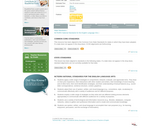
After this lesson students will be able to combine word choice and procedural writing; thus enhancing their overall writing skills.

In this module, students consider the guiding question: How do writers capture a reader's imagination? as they take a deep study of the classic tale Peter Pan.
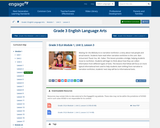
This lesson helps students move to nonfiction. Students will begin to think about how they can collect information from different types of texts.

In this lesson, students identify the main message or lesson of a story using key details from the text and effectively participate in a conversation with peers and adults.
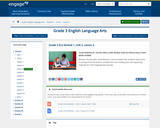
In this lesson, student identify the main message or lesson of a story using key details from the text.
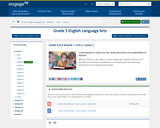
In this lesson, student identify the message or lesson of a story using key details from the text.
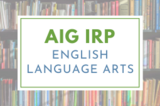
This activity for gifted learners might serve as part of a larger poetry unit. Students will take part in close readings of a variety of poems throughout the unit. In this activity, gifted learners would work individually to close read “Fireflies” by Paul Fleischman. They will then work to decipher the poem and it’s meaning, resulting in a new “Firefly Job Posting” (created in verse) to complement their knowledge/understanding of the poem. They will then participate in a “Networking Event for Fireflies” with their peers and listen to others’ “firefly job posting” ideas, share their own ideas, and give/receive feedback regarding their ideas, word choice, metaphors, etc, which will culminate in a “Classified Ad” page for fireflies…. a compilation of the students’ work / poetic reinterpretations of “Fireflies.” This lesson was developed by NCDPI as part of the Academically and/or Intellectually Gifted Instructional Resources Project. This lesson plan has been vetted at the state level for standards alignment, AIG focus, and content accuracy.
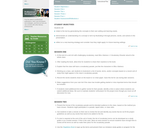
In this lesson, students combine vocabulary exploration with word play by planning their own vocabulary parade, modeled on the activities in the text after a read-aloud of the picture book, Miss Alaineus: A Vocabulary Disaster. Students brainstorm a list of vocabulary terms from a recent unit of study and then design concrete ways to illustrate the terms. The presentation of terms can be in the form of a parade, or a video, which might play during parent conferences or open house.

Students will learn the difference between the genres, then work collaboratively to identify genres and subgenres. Lessons within the unit have a powerpoint introduction, group work, as well as homework.